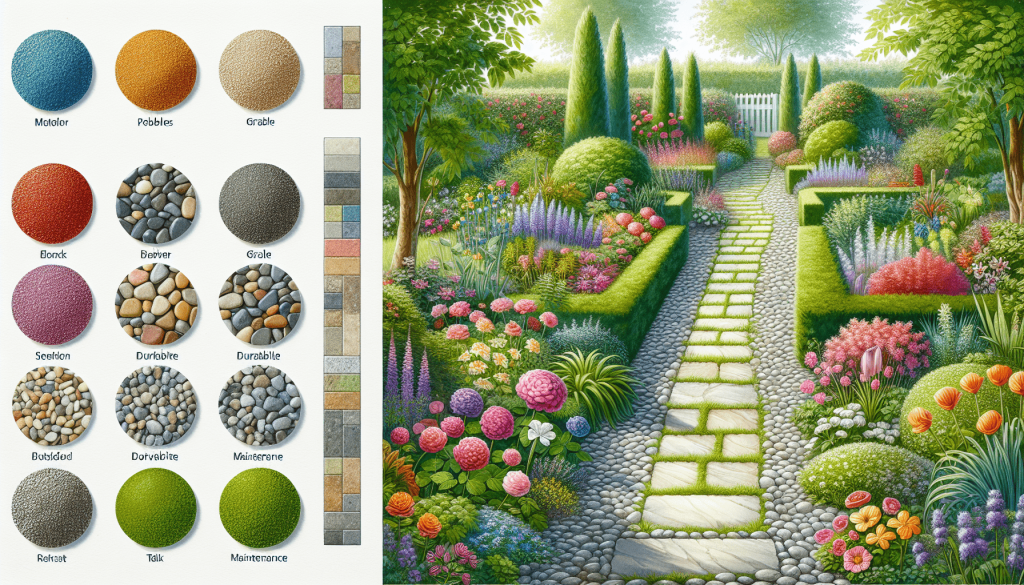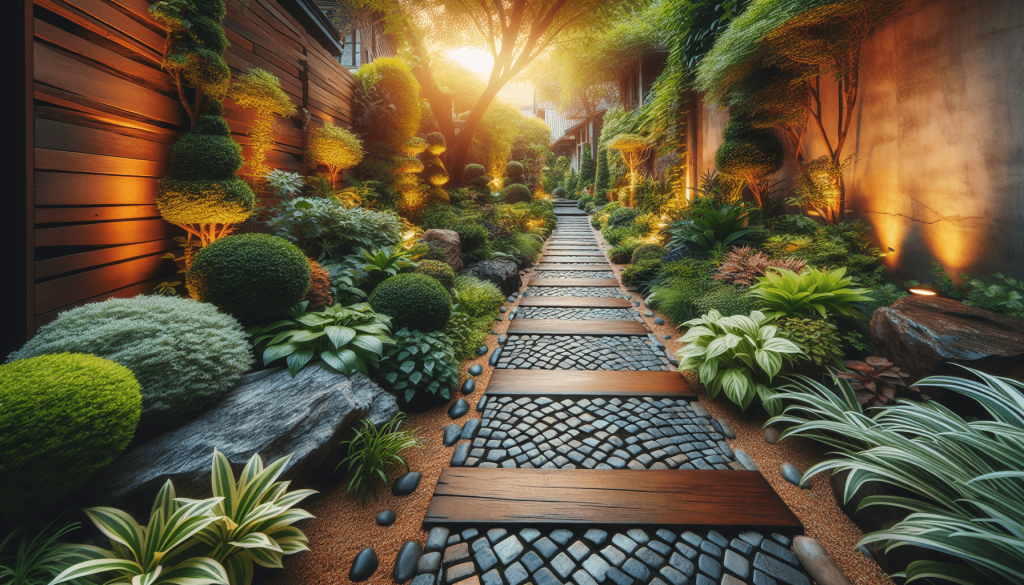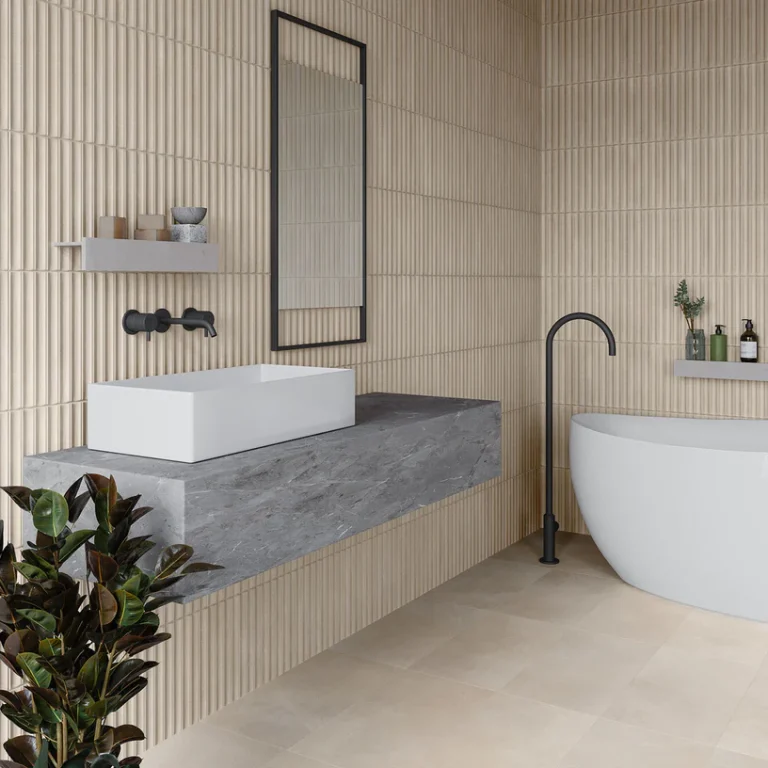Are you looking to create a stunning garden pathway but unsure about what materials to use? Choosing the right type of pathway materials can greatly impact the overall aesthetic and functionality of your garden. Whether you prefer a natural and rustic look or a sleek and modern design, this article will guide you through the process of selecting the perfect materials for your garden pathway. From gravel to concrete to pavers, we’ll explore the various options available, discussing their pros and cons to help you make an informed decision. Get ready to transform your garden into a picturesque paradise!
Table of Contents
ToggleConsider the Climate and Weather Conditions
Assess the average temperature and precipitation
Before selecting the materials for your garden pathway, it’s crucial to assess the average temperature and precipitation in your area. Understanding the climate conditions will help you choose materials that can withstand the elements and maintain their quality over time. If you live in a region with high rainfall, you may want to opt for materials that are less likely to get damaged by excess moisture.
Take note of extreme weather conditions
Apart from considering the average climate conditions, it’s also essential to take note of any extreme weather conditions that your garden pathway may be exposed to. If you experience heavy snowfall or frequent temperature fluctuations, you’ll need to choose materials that can handle such conditions without cracking, warping, or deteriorating.
Choose materials that can withstand the climate
After evaluating the climate and weather conditions, it’s time to choose materials for your garden pathway that can withstand the challenges posed by your specific environment. For example, if you live in an area with scorching summers, materials like concrete or stone are excellent choices as they can retain their strength and appearance even in high temperatures. On the other hand, if you often face freezing temperatures, opting for materials like rubber or gravel can prevent damage caused by expanding ice. Always ensure that the materials you choose are suitable for the climate in your region.
Evaluate the Function and Purpose of the Pathway
Determine the primary use of the pathway
Before deciding on the materials for your garden pathway, it’s essential to determine its primary use. Do you intend to use the pathway for leisurely strolls through your garden, or is it meant to be a functional route for accessing different areas? This consideration will help you determine the appropriate width, texture, and design of the pathway, which in turn will influence the choice of materials.
Consider the desired aesthetics and design
The aesthetics and design of your garden pathway play a significant role in creating a visually appealing and harmonious outdoor space. Consider the overall style and theme of your garden when selecting the materials for the pathway. For a rustic and natural look, materials like gravel or mulch can blend seamlessly with the surrounding greenery. On the other hand, if you desire a more formal and structured pathway, options like concrete, pavers, or bricks can provide a clean and elegant appearance.
Think about the level of foot traffic
The level of foot traffic that your garden pathway will experience is another crucial factor to consider. If your pathway will receive heavy foot traffic, such as in a frequently used entrance area, you’ll need to select materials that are durable and can withstand constant use without wearing down or becoming damaged. In such cases, robust options like concrete or pavers are excellent choices as they can handle the weight and provide a stable surface.
Decide if the pathway needs to accommodate wheeled equipment
In addition to foot traffic, it’s important to consider whether your garden pathway needs to accommodate wheeled equipment like wheelbarrows, lawnmowers, or bicycles. If you plan on using such equipment on the pathway, you’ll need to choose materials that offer a smooth and even surface for easy navigation. Concrete or pavers are often preferred for this purpose, as they provide a stable base and offer maneuverability for wheeled equipment.
Analyze Maintenance Requirements
Assess the level of maintenance you are willing to perform
Maintenance is a crucial aspect when selecting the materials for your garden pathway. Consider the amount of time and effort you are willing to invest in maintaining the pathway’s appearance and functionality. Some materials require regular cleaning, sealing, or repairs, while others need minimal upkeep.
Consider the longevity of the materials
Another important factor to consider is the longevity of the materials. You want your garden pathway to withstand years of use without needing frequent replacements or repairs. Concrete and natural stone are known for their durability and can withstand heavy use for a long time. On the other hand, materials like wood or mulch may require more frequent replacement or repair due to their vulnerability to decay or wear.
Factor in the cost and effort of repairs and replacements
When analyzing maintenance requirements, it’s crucial to factor in the cost and effort involved in repairs and replacements. Some materials may be initially inexpensive, but if they require frequent repairs or replacements, the long-term costs can quickly add up. Consider the long-term investment and choose materials that align with your budget and maintenance capabilities.
Choose materials that fit your maintenance preferences
Ultimately, it’s important to choose materials that fit your maintenance preferences and capabilities. If you have a busy schedule and prefer low-maintenance options, materials like concrete or pavers may be the best choice. However, if you enjoy gardening and are willing to put in the effort for maintaining a more natural-looking pathway, materials like gravel or mulch could be more suitable.
Explore Different Types of Garden Pathway Materials
Natural stone
Natural stone is a popular choice for garden pathways due to its timeless and elegant appearance. It comes in various forms such as flagstone, limestone, or slate, each offering unique textures and colors. Natural stone is highly durable, can withstand heavy foot traffic, and requires minimal maintenance. However, it can be more expensive than other materials and may require professional installation.
Concrete
Concrete is a versatile and cost-effective option for garden pathways. It comes in different finishes, including stamped, exposed aggregate, or stained, allowing for various design possibilities. Concrete is highly durable and requires minimal maintenance. However, it can be prone to cracking in extreme weather conditions, and repairs can be challenging to match the existing color and texture.
Brick
Brick pathways offer a classic and traditional aesthetic that complements many garden styles. They are durable, require low maintenance, and are available in various colors and patterns. Brick pathways can be laid in different designs, such as herringbone or basket weave, adding visual interest to your garden. However, bricks can become uneven over time and may require occasional releveling.
Gravel
Gravel pathways create a relaxed and informal vibe in gardens. They are relatively easy to install and require minimal maintenance. Gravel allows for good drainage and can be an excellent choice for areas with heavy rain. However, it may need occasional replenishment due to displacement or spread caused by foot traffic.
Wood
Wooden pathways provide a natural and rustic feel to gardens. They can be made from various types of wood, such as cedar or pressure-treated lumber. Wood pathways are comfortable to walk on and can blend well with surrounding plants and trees. However, wood is susceptible to rot, decay, and weather damage, requiring regular maintenance, sealing, and occasional replacement.
Pavers
Pavers offer a wide range of design possibilities for garden pathways. They come in different materials, including concrete, clay, or natural stone, and are available in various shapes, colors, and sizes. Pavers are durable, easy to replace or repair, and offer excellent stability. However, the cost of pavers can be higher compared to some other materials.
Rubber
Rubber pathways are an eco-friendly and soft option for garden paths. Made from recycled materials, rubber pathways are comfortable to walk on and provide excellent traction. They are low maintenance, slip-resistant, and come in various colors and patterns. However, rubber pathways may not be suitable for all garden styles due to their modern appearance.
Mulch
Mulch pathways create a natural and organic look in gardens. They are cost-effective and easy to install. Mulch helps retain moisture in the soil and reduces weed growth. However, mulch may require occasional replenishment to maintain its appearance and functionality. It may also be less suitable for areas with heavy foot traffic.
Grass
Grass pathways offer a seamless and green integration into your garden. They are visually pleasing and create a soft surface to walk on. Grass pathways can be established by planting grass seed or installing sod. However, grass pathways may need regular mowing, watering, and maintenance to keep them looking neat and well-tended. They may not be suitable for areas with high foot traffic.
Consider the Pros and Cons
Evaluate the durability and longevity of each material
When choosing the right type of garden pathway materials, it’s important to evaluate the durability and longevity of each option. Materials like concrete, natural stone, or pavers are known for their durability and can withstand heavy foot traffic for many years. On the other hand, materials like wood or mulch may require more frequent repairs or replacements due to their vulnerability to weathering and decay.
Assess the aesthetic appeal of each material
The aesthetic appeal of the materials should also be considered. Each material has its unique look and feel, which can significantly impact the overall appearance of your garden. Natural stone and brick offer a classic and timeless charm, while gravel and mulch provide a more relaxed and natural look. Concrete and pavers offer a clean and modern appearance that can complement a variety of garden styles.
Consider the cost and availability of each material
The cost and availability of materials are important considerations when choosing the right type of garden pathway materials. Some materials, like concrete or gravel, are generally more affordable and readily available. However, more specialized options like natural stone or specific types of wood may be more expensive and require sourcing from specific suppliers or nurseries.
Analyze the maintenance requirements of each material
Maintenance requirements can greatly impact your choice of garden pathway materials. Materials like concrete, pavers, or rubber usually require minimal maintenance, making them suitable for those who prefer low upkeep options. On the other hand, materials like wood or grass may require regular maintenance, sealing, or replanting to keep them looking their best.
Think about the eco-friendliness and sustainability of each material
Considering the environmental impact of the materials is crucial when making your selection. Some materials, like rubber or recycled mulch, are more environmentally friendly as they are made from recycled materials. Others, like natural stone or pavers, may have a larger carbon footprint due to energy-intensive production processes. Choosing locally sourced or sustainable materials can help reduce the environmental impact of your garden pathway.
Seek Inspiration and Gather Ideas
Browse online resources and garden design websites
When choosing the right type of garden pathway materials, it’s always helpful to browse online resources and garden design websites for inspiration. Many websites offer a variety of photos and design ideas that can help you visualize different materials in various garden settings. This can give you a better understanding of how different materials can complement your overall garden design.
Visit local gardens and parks
Visiting local gardens and parks can be a great source of inspiration for your garden pathway materials. Take note of the materials used in inspiring pathways and observe how they blend with the surrounding environment. Visiting these places can also provide you with an opportunity to see the materials in person and assess their durability, texture, and overall appeal.
Take note of materials used in inspiring pathways
As you explore different gardens and outdoor spaces, make sure to take note of the materials used in inspiring pathways. Observe how these materials perform over time and consider their suitability for your own garden. Note any positive or negative aspects that may influence your decision-making process.
Consider the overall theme and style of your garden
When choosing the right type of garden pathway materials, it’s important to consider the overall theme and style of your garden. The pathway should complement the existing elements and create a cohesive look. For example, if you have a traditional English garden, materials like brick or natural stone can provide a timeless charm. On the other hand, a contemporary garden may benefit from clean lines offered by concrete or pavers.
Consult with Professionals or Experts
Seek advice from landscape designers or architects
Consulting with landscape designers or architects can be highly beneficial when choosing the right type of garden pathway materials. These professionals have extensive experience and knowledge in designing outdoor spaces and can provide valuable insights and recommendations based on your specific needs and preferences. They can help you navigate through various options and ensure that your pathway choice aligns with the overall design of your garden.
Visit garden centers or nurseries for recommendations
Garden centers and nurseries are excellent places to seek advice and recommendations for garden pathway materials. The staff members are often well-informed about different materials and can provide insights into their pros and cons. They can help you select materials that are suitable for your climate, personal style, and budget. Additionally, they may have samples or displays that allow you to visualize the materials in person.
Ask for input from experienced gardeners
Experienced gardeners can provide valuable firsthand knowledge and insights into choosing the right type of garden pathway materials. They have likely experimented with different materials in their own gardens and can offer advice based on their personal experiences. Reach out to gardening communities or local gardening groups to connect with experienced individuals who can guide you in making the best choice for your pathway.
Consider hiring a contractor for installation
If you are unsure about the installation process or want to ensure professional results, it may be worth considering hiring a contractor for the installation of your garden pathway. Contractors have the expertise and equipment necessary to accurately install the materials, ensuring a long-lasting and visually appealing pathway. They can also offer recommendations on materials and design based on their experience.
Budget and Cost Considerations
Determine your overall budget for the pathway project
Setting a budget for your garden pathway project is essential to ensure that you stay within your financial constraints. Determine the maximum amount you are willing to spend on materials, installation, and any additional expenses like maintenance or repairs. This will help you narrow down your options and choose materials that fit your budget.
Compare the costs of different materials
When choosing the right type of garden pathway materials, it’s important to compare the costs of different options. Some materials may be more affordable upfront but require frequent maintenance or replacement, which can increase the long-term costs. Consider the overall durability, maintenance requirements, and lifespan of the materials to make an informed decision that aligns with your budget.
Factor in additional expenses such as installation and maintenance
In addition to the cost of materials, it’s crucial to factor in additional expenses like installation and maintenance. Some materials may require professional installation, which can increase the overall project cost. Additionally, materials with higher maintenance requirements may require ongoing expenses for cleaning, sealing, or repairs. Consider these additional expenses when determining the feasibility of each material within your budget.
Choose materials that align with your budget
Ultimately, it’s important to choose materials that align with your budget and financial capabilities. By considering the upfront costs, long-term maintenance requirements, and potential for replacements or repairs, you can make a decision that fits comfortably within your budget. Remember that investing in durable materials may result in fewer maintenance expenses in the long run, creating a more cost-effective solution.
Test the Materials
Request samples or visit showrooms
Before finalizing your selection, it’s beneficial to request samples or visit showrooms to physically examine the materials you are considering. By touching, feeling, and seeing the materials in person, you can better assess their texture, color, and overall quality. This firsthand experience will give you a clearer idea of how each material will look and feel in your garden.
Assess the texture, color, and feel of the materials
When testing the materials, pay attention to their texture, color, and feel. Consider how these elements will contribute to the overall aesthetics of your garden and whether they align with your desired outcome. For example, if you prefer a smooth and sleek pathway, a material with a rough texture might not be the best choice.
Consider how the materials blend with the surrounding elements
During the testing phase, it’s important to consider how the materials will blend with the surrounding elements in your garden. Assess whether they complement the plants, trees, or architectural features in the area. The materials should seamlessly integrate with the overall design, enhancing the beauty of your outdoor space.
Evaluate the comfort and safety of walking on each material
Another important aspect to consider is the comfort and safety of walking on each material. Test the materials by walking on them barefoot or with different types of footwear to determine their comfort level. Additionally, consider factors like slip resistance and the impact of weather conditions on the materials’ safety. Choose materials that provide a comfortable and secure walking surface for you and your guests.
Consider Long-Term Impact on the Environment
Research the sustainability of each material
When selecting the right type of garden pathway materials, it’s important to research the sustainability of each option. Look for materials that are sourced and manufactured using environmentally friendly practices, such as recycled or responsibly harvested materials. Sustainable materials can reduce the overall environmental impact of your garden and contribute to a healthier ecosystem.
Evaluate the environmental impact of production and disposal
Consider the environmental impact of the production and disposal processes associated with each material. Some materials may have a larger carbon footprint due to energy-intensive manufacturing processes or limited recycling options. Opting for materials that have minimal environmental impact throughout their lifecycle can help you create a more eco-friendly garden.
Consider using recycled or locally sourced materials
Choosing recycled or locally sourced materials is another way to minimize the environmental impact of your garden pathway. Recycled materials can reduce waste and conserve natural resources. Locally sourced materials have a lower carbon footprint as they do not require extensive transportation. By supporting local suppliers and choosing recycled options, you can make a positive contribution to the environment.
Choose materials that reduce water runoff or promote wildlife habitat
Lastly, consider how each material can contribute to reducing water runoff or promoting wildlife habitat in your garden. Some materials, like permeable pavers or gravel, allow rainwater to seep into the ground, reducing stormwater runoff and supporting groundwater recharge. Others, like wood or mulch, can provide habitats for beneficial insects or small animals. By choosing materials that have ecological benefits, you can create a more sustainable and wildlife-friendly garden.
In conclusion, choosing the right type of garden pathway materials requires careful consideration of various factors. Assessing the climate and weather conditions, evaluating the pathway’s function and purpose, and analyzing maintenance requirements are crucial initial steps. Exploring different types of pathway materials, considering their pros and cons, and seeking inspiration from professionals, experts, and local gardens is important in making an informed decision. Budget and cost considerations, material testing, and the long-term impact on the environment are also significant factors to evaluate. By following these steps and considering each aspect, you can select the perfect garden pathway materials that will enhance the beauty, functionality, and sustainability of your outdoor space.








